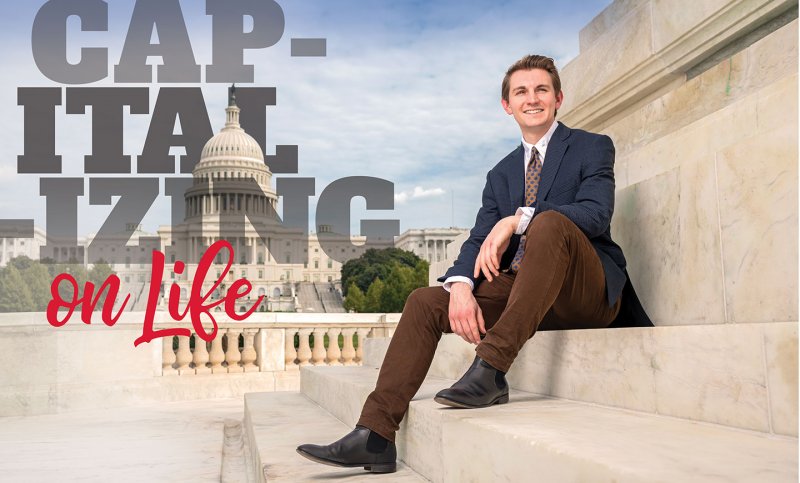
OWU alumni reflect on why they love the capital city of Washington, D.C., and why you will too
Gaze across the grassy expanse of the National Mall in Washington, D.C. — with the stately U.S. Capitol on one end and the Washington Monument rising in the other — and it’s hard not to feel a sense of awe. Such iconic city vistas are why tourists from around the world and D.C. residents alike revel in and revere the District of Columbia.
It only took one summer in the nation’s Capital to convince Sara Amy Leach ’80 to return for good. After her experience interning in the public relations department at the Corcoran Gallery of Art (now the Corcoran School of the Arts and Design) before senior year at OWU, “I packed up my Volkswagen and headed right back here after graduation,” says Leach, whose District career has taken her from the Washington Business Journal to the Smithsonian Institution, the National Park Service, and now the National Cemetery Administration of the U.S. Department of Veterans Affairs, where she’s a senior historian. “I absolutely fell in love with the city of D.C.”
With Washington at the center stage of politics and government, plus home to so many organizational headquarters, world-class restaurants and entertainment, nationally known museums, and more, it’s no wonder OWU alumni residents feel like they’re in the heart of it all.
Political capital
“D.C. is where the conversations are happening,” says Irfan Nooruddin ’96. Formerly a professor at the Ohio State University, Nooruddin came to Washington in 2014 to serve as a professor and director at the Georgetown India Initiative at Georgetown University. In D.C., he’s had the opportunity to join discussions with policymakers from South Asia and the broader global community, as well as the federal government — participating in a way he wouldn’t be able to elsewhere.
“The opportunity to be in the center of national and international politics was too attractive to pass up,” says Nooruddin, whose work and study on issues in India, South Asia, and global politics has included the D.C.- based IMF and the World Bank.
An interest in public policy also drew Tom Dolan ’18, to D.C., where he’s a staff assistant for Rep. Neal Dunn (R-FL). Dolan hails from Maryland, but it was two Capitol Hill internships during college — including a Wesleyan in Washington semester — that won him over. “I was interested in the policy side of the career, and the Hill was the best place to start,” says Dolan, who thrives in the fast-paced atmosphere on Capitol Hill.
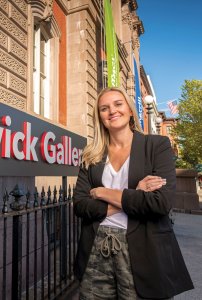
In the business world, working with government-related clients requires its own skill set to handle the level of detail and budget required, explains Stephanie Taylor ’07, a producer at Ogilvy PR, who works largely with government contracts, a client base unique to the D.C. area.
In addition to government agencies, many internationally-reaching nongovernmental organizations, institutions, foundations, and charities base their headquarters in D.C., creating unique opportunities to make contacts, says Susan Headden ’77, whose 25 years in D.C. included working at U.S. News and World Report and the Bill and Melinda Gates Foundation before her current role as an independent communications consultant. “I’m constantly running into people that I know,” says Headden. “The networking here is fantastic.”
For the people, by the people
It’s D.C.’s wide diversity of people, ethnicities, ideas, and backgrounds that many find so intriguing. “This town is so motivated in that everybody is here for a cause, be it environmental or policy-making,” says Courtney Durham ’12, who works on Coastal Wetlands and Coral Reefs at Pew Charitable Trusts, a nonprofit, nongovernmental organization that advances public policy. “It’s such an interesting melting pot of many different thematic interest areas,” says Durham, who grew up in Silver Spring, Maryland, just outside of D.C., and returned to the city after graduating from OWU.
Nooruddin and his wife Heidi Sherman ’98 met at OWU and now live in Chevy Chase, D.C. He says living in such an international community has meant having daughters who become friends with children of foreign diplomats. “For them to be able to grow up in a neighborhood where there are a lot of people from around the world, they learn that the world isn’t a scary place, but a place of opportunity,” he says.
With frequently changing political offices, D.C. can be a somewhat transient city, with workers here for a short time. The city and surrounding area has attracted many young professionals, who are putting down roots and starting families. Durham has noticed a lot of millennials moving to the area in the past decade.
This younger generation has brought a new vibe to an old city. Says Bridget Newton ’80, mayor of nearby Rockville, Maryland. “There’s a buzz about the District that’s just fun.”
A taste of D.C.
The international nature of D.C.’s population extends to its robust restaurant scene. “We’re seeing oodles of new restaurants and eateries,” says Leach. “The attraction is the endless choice of international foods that are here.” The entire metropolitan area boasts authentic cuisine from every corner of the world. Diners will find Ethiopian, Latvian, Peruvian, Lithuanian, Indian, Ghanaian, Salvadoran, Thai, Irish, Chinese, Greek, and German restaurants, in addition to the American standard of seafood, barbecue, and steakhouses. “It’s sort of like dining room travel,” Leach says.
Durham echoes her love of D.C. as a food city, citing the increasing number of star chefs who have gained prominence in the city, such as Jose Andres. Like other alumni, she’s noticed the variety and caliber of restaurants take off in the last five years — “since the Obama years,” she estimates.
Long-time resident alumni attest to a D.C. that not only offers new restaurants, but growth of all kinds. Newton recalls when she first moved to the area post-graduation that a police officer warned her to avoid driving 14th Street at night. Now the 14th Street corridor boasts acclaimed restaurants, shops, and businesses. “It’s amazing to me, the changes downtown,” says Newton, who’s lived in Rockville, 13 miles north of D.C., since 1981 with husband Fred Newton ’80.
Washingtonians know the city and its environs by neighborhood or community — Arlington, Bethesda, Capitol Hill, Columbia Heights, National Harbor, Georgetown, Dupont Circle, Adams Morgan, NoMa, Chinatown, and The Wharf, to name a few. Each has a particular character and feel, along with unique businesses and neighbors, lending to the diverse climate of the city.
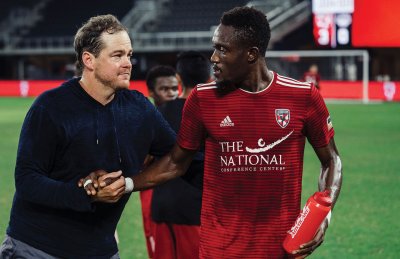
“I like exploring the different pockets of D.C. — Shaw, Petworth, Logan Circle, Georgetown,” says Ryan Martin ’05, head coach for the newly formed Loudoun United FC team, a second-division team under D.C. United. Between the monuments, events, concerts, and festivals, “it always seems like there’s something going on,” says Martin.
That’s a boon for current residents, especially those who have seen recent decades draw out a new kind of international city.
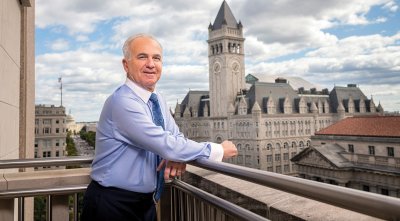
“The changes in the area have been incredible,” says Nick Calio ’75, President & CEO of Airlines for America, who remembers when Logan Circle was a red light district. Now it’s a vibrant area with restaurants, shops, and renovated buildings. “It is a far more vibrant, sophisticated city than it was when I moved here in ’78,” says Calio, who in past decades has worked for both President Bushes, and represented companies as a lawyer and a lobbyist. As a result of the new construction, many younger professionals have moved into the city.
“In 1980, it was still a very gentle, sleepy southern town,” says Leach, who lives in Arlington, Virginia, and commutes to her office in the NoMa neighborhood (North of Massachusetts Avenue, east of Union Station), where she says no one would have walked through a decade ago but is now an up-and-coming area. “It’s been fascinating to see the city fill out its empty spaces and underutilized lots.”
Walk this way
With years of growth, however, has come notoriously bad traffic, OWU alumni say. But a convenient Metro and public bus system, along with increasing bike lanes, easy walking, and a robust Uber/Lyft option, make getting around easier.
Like many residents, Taylor prefers the plentiful public transportation and car ride options such as Uber, but owns a car for when she needs to leave the District.
But by far, alumni residents say they love to walk, and wide sidewalks on every street make it possible for pedestrians to access every area of the city. “You can walk this city very easily,” says Calio, who’s married to alumna Lydia Keller Calio ’77.
Martin, son of OWU men’s soccer coach Jay Martin, enjoys hopping on his hybrid bicycle to get around the city and enjoy surrounding scenic biking/walking trails, including the popular historic Chesapeake & Ohio Canal trail that follows the Potomac River for 184.5 miles from Cumberland, Maryland, into the heart of Georgetown.
If you need to get out of town, travel options include three major metropolitan airports, plus a major Amtrak station, luxury bus lines, and Interstate 95, which runs the length of the East Coast.
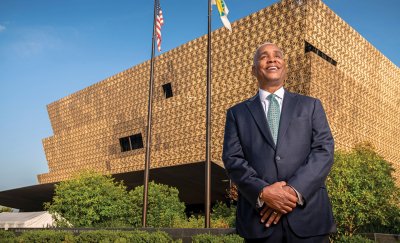
“One thing that makes it attractive is that it’s easy to go up and down the Eastern Seaboard,” says Gregory Dyson ’80, chief operating officer and executive vice president at the American Nurses Association in Silver Spring, Maryland. The city’s location makes it three hours by Amtrak train to New York, as well as a two-hour drive to ocean or mountains.
Though it has a vital role as the center of the U.S. government, D.C. maintains authentic character and appeal. “It’s such a manageable city — I feel really comfortable here,” Taylor says, because it’s clean, friendly, and highly walkable. “It’s big enough, but not so big that you feel lost.”
Hot and humid, with Southern charm
Though summer in D.C. often means scorching heat and high humidity, residents savor the changing of the four distinct seasons. The city especially shines during temperate springs and falls, when trees and flowers offer blossoms and showy leaves. Known for its flowering cherry trees, the entire area anticipates the peak cherry blossom season in late April, when the annual Cherry Blossom Festival draws crowds to stroll the Tidal Basin area, one of D.C.’s beautiful park-like areas. “D.C. has this great balance of feeling urban and really green at the same time,” says Taylor.
The District’s residents treasure not only the many green spaces, but also the tree canopy along many streets. Leafy D.C. has nearly a 38 percent tree cover, making it among the greenest cities in America based on canopy cover, according to Durham. In addition to green appeal, D.C.’s lack of skyscrapers creates a signature skyline.
Says Dyson, a native Washingtonian, “It’s a big city with a lot of Southern charm.”
By Carrie Madren ’02, a freelance writer living in Great Falls, Virginia.
